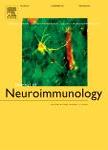版权所有:内蒙古大学图书馆 技术提供:维普资讯• 智图
内蒙古自治区呼和浩特市赛罕区大学西街235号 邮编: 010021

作者机构:Arizona State Univ Biodesign Inst Ctr Innovat Med Tempe AZ 85287 USA Arizona State Univ Mol & Cell Biol Program Tempe AZ 85287 USA Arizona State Univ Sch Life Sci Tempe AZ 85287 USA
出 版 物:《JOURNAL OF NEUROIMMUNOLOGY》 (神经免疫学杂志)
年 卷 期:2013年第254卷第1-2期
页 面:154-160页
核心收录:
学科分类:1001[医学-基础医学(可授医学、理学学位)] 10[医学]
基 金:Arizona Alzheimer's Consortium [AGR200737] Alzheimer's Drug Discovery Foundation
主 题:Alzheimer's disease Immunosignaturing Peptide microarray Dementia diagnosis
摘 要:A practical diagnostic test is needed for early Alzheimer s disease (AD) detection. Immunosignaturing, a technology that employs antibody binding to a random-sequence peptide microarray, generates profiles that distinguish transgenic mice engineered with familial AD mutations (APPswe/PSEN1-dE9) from non-transgenic littermates. It can also detect an AD-like signature in humans. Here, we assess the changes in the immunosignature at different time points of the disease in mice and humans. We also evaluate the accuracy of the late-stage signature as a test to discriminate between young mice with familial AD mutations from non-transgenic littermates. Plasma samples from AD patients were assayed 3-12 months apart, while APPswe/PSEN1-dE9 and non-transgenic controls supplied plasma at monthly intervals until they reached 15 months of age. Microarrays with 10,000 random-sequence peptides were used to compare antibody binding patterns. These patterns gradually changed over the life-span of mice. Strong, characteristic signatures were observed in transgenic mice at early, mid and late stages, but these profiles had minimal overlap. The signature of young transgenic mice had an error rate of 18% at classifying plasma samples from late-stage transgenic mice. Conversely, the late-stage transgenic mice signature discriminated between young transgenic mice and littermates with an error rate of 21%. Less distinctive profiles were recognizable throughout the transgenic mice lifespan, being detectable as early as 2 months. The human signature had minimal change on short-term follow-up. Our results call for a reappraisal of the way incipient AD is studied, as biomarkers seen in late-stages of the disease may not be relevant in earlier stages. (C) 2012 Elsevier B.V. All rights reserved.